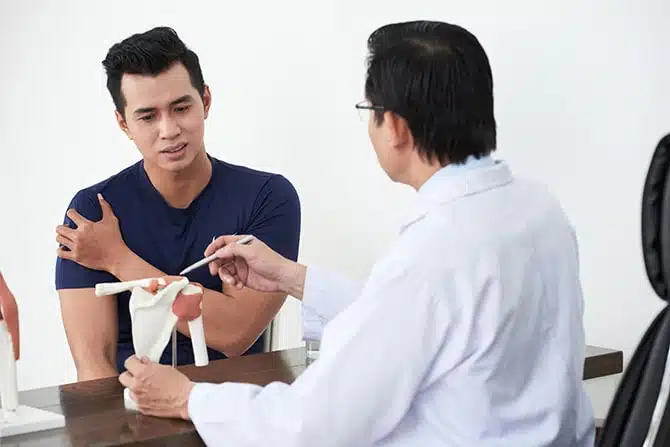
When your shoulder bothers you to the points that you can't move your arm properly, you may feel as if you're trying to live your life with one hand tied behind your back. If you want to regain your former comfort and functionality, you've got to find the answer to your shoulder pain. Fortunately, our Newport Beach, Torrance, and San Pedro chiropractor at Zaker Chiropractic has those answers -- as well as the non-surgical treatment you need to get your shoulder working again. Take a look at these answers to some frequently asked questions about shoulder pain.

The shoulder is a ball-and-socket joint, which means that it rotate in a number of directions. But it also means that shoulder problems can occur at many points, from the rotator cuff (the muscles and tendons that mobilize the shoulder) and friction-reducing bursae to the cartilage that cushions the bone ends. Any of these structures can suffer from deterioration or damage, producing pain as a result. Some shoulder pain doesn't originate on the shoulder at all; it's simply referred pain from a pinched nerve in the spine.
A forceful impact to the shoulder can cause serious, immediate and painful injuries. The bones may break, or they may be pushed completely out of socket (dislocation). Hyperextended rotator cuff tissues may also stretch and/or tear.
Bursitis occurs when the tendons that pass over the bursae cause unnatural friction and irritation. The resulting pain may be most noticeable when lifting your arm over your head or trying to sleep on the affected shoulder.

Frozen shoulder, or adhesive capsulitis, is an odd stiffening of the shoulder tissues. It often occurs after you've been forced to keep your shoulder immobile for a long period of time (as in recovery from a fractured arm).
Constant or extreme overuse of your shoulder can cause small but cumulative amounts of damage to the tissues, gradually causing tendinitis and chronic muscle strain. Over time, the cartilage that normally separates the bone ends in the shoulder may thin out and break up, leaving you with arthritis pain.
Chiropractors may use a variety of methods to figure out what's behind a case of shoulder pain. Our chiropractor will x-ray the shoulder to look for obvious alignment issues or internal damage, while also examining the shoulder for signs of inflammation and asking you about your symptoms. You may also be asked to move your shoulder in different directions so we can check your range of motion.

The methods our chiropractor uses to treat your shoulder pain will depend in part on exactly where the shoulder pain originates. If you're experiencing referred pain from the spine, we may administer chiropractic adjustments and spinal decompression therapy to free up that pinched nerve. Strained muscles and inflamed tendons may require massage, cryotherapy, or other forms of physiotherapy to reduce pain and promote healing. Physiotherapy and sports rehabilitation therapy can help you regain your range of motion and build up the strength in your shoulder.
Periodic spinal screenings can help us catch a misalignment or other condition that threatens to cause nerve impingement and referred shoulder pain. Our team of holistic trainers and therapists can also recommend exercises, changes to your sports technique, and other lifestyle changes that can help you keep your shoulder strong and stable.
Now that you have the answers to some of your shoulder pain questions, your next questions is probably, "How do I get started on my road to relief? The answer to that one is easy: Call our Newport Beach, Torrance, or San Pedro office to schedule an evaluation and treatment with our chiropractor at Zaker Chiropractic!
